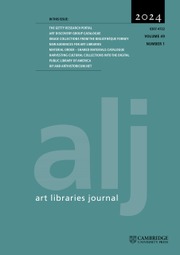No CrossRef data available.
Article contents
Smithsonian Libraries & Archives: BIBFRAME linked data experiment with the Share Family technology
Published online by Cambridge University Press: 14 April 2025
Abstract
The semantic web promises interlinks of cultural heritage objects, both original and digital, of which the Smithsonian Institution (SI) holds plenty in artifacts, books, audio/video, etc. At the core, structured data in RDF is likely the one member of data infrastructure that carries the major lifting for interlinking. Parsing millions of bibliographic data mainly locked in MARC21 into the BIBFRAME/RDF syntax is not an insignificant endeavour for the library community. The Smithsonian Libraries & Archives, a network of specialized libraries (including art and design), is not an exception. It became part of the Share Family to utilize its technology so as to increase user resource discovery and the library staff’s ability to resource curations. Working collaboratively with scores of research, academic and national libraries, and the Share Family team, the Smithsonian Libraries & Archives experimented with BIBFRAME, a Library of Congress RDF-based ontology, which has benefited greatly from the Share-VDE semantic technology and its system design. From such efforts, the Smithsonian Libraries & Archives looks to move away from the web of documents into a web of data. Fulfilling SI’s strategic vision of availing collections through digital solutions for the increase and diffusion of human knowledge.
Information
- Type
- Research Article
- Information
- Copyright
- © Smithsonian Institution, 2025. This is a work of the US Government and is not subject to copyright protection within the United States. Published by Cambridge University Press on behalf of ARLIS
References
1. Tim Berners-Lee, [Semantic Web (Web 3.0)] Design Issues, accessed March 4, 2024, https://www.w3.org/DesignIssues/Overview.html; “The Next Web,” filmed February 2009, video, 16:03, https://www.ted.com/talks/tim_berners_lee_on_the_next_web.
2. Berners-Lee, “Relational Databases on the Semantic Web,” Design Issues.
3. Berners-Lee, “Axioms of Web Architecture,” Design Issues.
4. Cataloguing principles and practices trace its roots for almost 150 years–from Charles Cutter’s Object of Cataloguing (1876) to the Paris Principles (1961) and its revision, the IFLA International Cataloguing Principles in 2009 and the various revisions of Anglo-American Cataloguing Rules (1967, 1978, 1988-2002).
5. Bibliographic Framework Initiative, last modified January 31, 2024, https://www.loc.gov/bibframe/.
6. LSP providers (EBSCO FOLIO, Index Data FOLIO, ExLibris, OCLC) shared BIBFRAME roadmap in the BIBFRAME Workshop in Europe, 2023, https://www.bfwe.eu/brussels_2023.
7. Overview of the BIBFRAME 2.0 Model, accessed March 11, 2024, https://www.loc.gov/bibframe/docs/bibframe2-model.html.
8. A series of library blogs by staff who shared their insights on Wikidata as a viable alternative to provide authority work on a non-library traditional platform. https://blog.library.si.edu/blog/tag/wikidata-series/.
9. Linked Data for Libraries (LD4L) Gateway, last modified October 6, 2020, https://wiki.lyrasis.org/display/ld4lgw.
10. Share Family: Linked Data Ecosystem, accessed March 13, 2024, https://www.share-family.org/ The Share Family: Cooperation and Interconnection for a Sustainable Linked Open Data Ecosystem, accessed June 1, 2024, https://www.cni.org/topics/metadata/share-family-cooperation-and-interconnection-for-a-sustainable-linked-open-data-ecosystem.
11. SVDE ontology model examples reformatted from Jim Hahn and Tiziana Possemato’s article, “The Share-VDE ontology: a BIBFRAME extension for linked data discovery” September 10, 2023. https://zenodo.org/doi/10.5281/zenodo.8332350.
12. Jackie Shieh. “Library Descriptive Data Unleashed in SVDE: Making Data More Meaningful,” Unbound (blog), September 14, 2022, https://blog.library.si.edu/blog/2022/09/14/library-descriptive-data-unleashed-in-svde-making-data-more-meaningful/.

